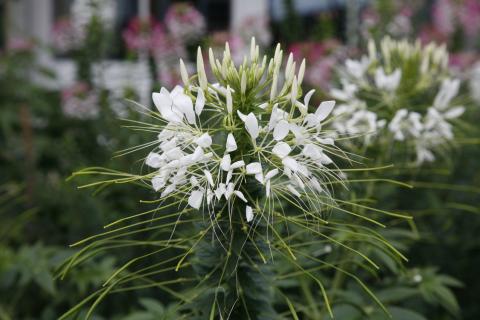Spider Flower
Despite its unfortunate name, the Spider flower is a popular annual plant for colorful summer flower beds. We introduce the South American beauty and provide planting and care tips.
Factsheet
- Growth type
-
- one year old
- Growth height (from)
- from 80 cm to 150 cm
- Growth width (from)
- from 40 cm to 70 cm
- Growth characteristics
-
- upright
- Flower color
-
- purple
- red
- pink
- white
- Flowering time (month)
-
- July to October
- Flower shape
-
- Cluster
- Leaf color
-
- green
- page format
-
- 3-piece
- 5-piece
- 7 pieces
- pointed
- Light
-
- sunny
- Soil type
-
- stony to sandy
- Soil Moisture
-
- moderately dry to fresh
- Lime compatibility
-
- lime-tolerant
- Nutrient requirements
-
- moderately nutritious
- Decorative or utility value
-
- Flower Decoration
- Winter Hardness
-
- frost-sensitive
- Use
-
- Flowerbeds
- Bouquets
- Garden fences
- Group planting
- Planters
- Rose companion
- Garden style
-
- cottage garden
- Flower garden
- Prairie Garden
- Rose Garden
- Pot garden
- Bee Friendly
- bee friendly plant
With such a name, it certainly wasn’t easy for the South American spider flower to win over flower lovers. But it succeeded: After persistently appearing at garden shows and in public parks, it became a trend plant and now adorns many a garden. The name is derived from the long-stalked carpels that remain on the plant after each individual flower fades, resembling the legs of a spider. In the plant kingdom, the spider flower and its relatives (which are less suitable for gardens) are members of the family Cleomaceae.
The spider flower is an annual that displays its flowers from July to October in loose terminal clusters. It grows to a height of 30 to 40 inches, while tall varieties reach heights of up to 60 inches. The Summer flowers grow from the ground with several shoots and do not branch out – as a result, the slightly thorny stems often look a little sparse. Flower colors range from violet, red and pink to white. The leaves are usually palmately compound and consist of three to seven tapered leaflets.

The Spider flower is happy in any sunny flower bed provided that the ground is not too dry. The Spider flower does not have any particular preference in terms of companion plants. Its delicate appearance goes just as well with the rounded flowers of Zinnia, Dahlia, and garden cosmos as with loose grasses or the slender flower spikes of a giant hyssop. The Spider flower also looks wonderful alongside the umbels of bishop’s weed, the "umbrella" of a radiant red coneflower, and purple top (Verbena bonariensis). At a height of up to 5 feet, tall varieties tower above many of their neighbors in the flower bed and have an incredible luminosity, especially in the backlight of the morning and evening sun. They also look wonderful in a vase and last for a long time. Recommended varieties are ’Helen Campbell' (white), 'Kirschkönigin' (carmine pink), and 'Violettkönigin' (violet).
Spider flowers can also be grown on their own in pots. If you have a spare pot, the best options are ’Señorita Rosalita' (pink), ’Señorita Carolina' (light pink), or ’Señorita Blanca' (white). Compared to other Spider flowers, these three varieties remain shorter, grow bushier, and do not have thorns.
A sunny location is important – after all, as a South American the Spider flower is used to a warm climate. It can even tolerate short periods of dryness. The soil should be moderately dry to fresh and very permeable, waterlogging should be avoided at all costs.
Seeds should be sown indoors from March at a temperature of 65 to 68 degrees Fahrenheit. The plants can be moved outdoors from mid-May. Prune young Spider flowers to encourage the formation of new shoots. As the plants naturally grow upright and remain unbranched, several plants should be grouped together (planting distance 15 inches). They also develop a great color effect, even from a distance. If you don’t want to sow your own Spider flowers, you can buy young plants from stores in April/May.
If you give the Spider flower a regular dose of liquid fertilizer, it will thank you with an abundance of flowers until the onset of frost. Regularly remove seed pods so that flower formation does not decline. However, if you want, you can also leave a few pods to ripen so that you have seeds for next year.

It is normal for the leaves and stems of the robust plant to feel sticky, and this is not a sign of an aphid infestation: They have glands that secrete a sticky substance. This also seems to be effective at protecting the plants against snails and slugs. They are however occasionally infested by the Black vine weevil. Its larvae can damage the roots so severely that the plants wilt and die off.

